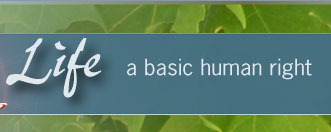
How the Culture of Death was Brought to American Medicine
Elizabeth D. Wickham, Ph.D.
Executive Director, LifeTree, Inc.
February 15, 2005
Dear all,
You may be dismayed that the United States Supreme Court refused last month to take the case of Terri Schiavo and wonder how this came to be!
As with the abortion movement, this right-to-die movement is based on a false philosophy of choice and is riddled with lies and confusion.
We at LifeTree have researched a campaign that that has been actively changing America's view on hastening death. We hope that this research will help you to better understand the well orchestrated effort that is underway to inflict the curse of euthanasia throughout our land. The Supreme Court's decision last month did not just happen. Much money and time paved the way.
This campaign has spent hundreds of millions of dollars to change a society's morality and public policies. It involves several non-profits, think tanks, and university chairs. It continues to reach young doctors, lawyers, nurses, as well as legislators and the general public.
One objective of this program was to institutionalize the very protocol that is planned for Terri Schiavo, should Judge Greer's decision remain final. Mainstreaming the idea of hastening death by withdrawal of food and water is just one success of this end-of-life program.
We offer some of this research in the form of a timeline on our website at http://www.lifetree.org/timeline.html. The chronology, long as it is, is still only an overview. We invite you to take time to become acquainted with it. You may want to print it (about 27 pages) and explore the many links to primary sources which have been gathered into this unique work.
A few brief comments will help you understand this chronology.
In retrospect, 1997 was a pivotal year.
The Supreme Court vote to let the Florida court ruling stand in the Schiavo case can be linked to another Supreme Court action in 1997. Although at the time pro-lifers claimed victory, the Supreme Court's decision in Vacco v Quill gave a major impetus to the right-to-die movement.
The Court held that states could make their own laws relating to the legality of physician assisted suicide. More importantly, their reasoning relied on a distinction between physician assisted suicide (lethal overdose or injection) and withdrawing life sustaining treatment.
Hindsight is sometimes 20-20, but earlier that same year, in an attempt to ensure that the federal budget would not subsidize physician assisted suicide in Oregon or elsewhere, Congress passed almost unanimously a bill to deny such funds. BUT, in that bill were exceptions which impliedly approved (1) the withholding or withdrawing of life sustaining treatment and (2) the treatment of pain even if it hastens death as long as death was not intended.
These 1997 events solidified the emergence of two distinct wings within the right-to-die movement - one was a more militant wing with Western origins including the Hemlock Society, Oregon Right to Die, Death With Dignity and Compassion in Dying (which promoted physician assisted suicide) and the other was a more nuanced wing whose periodic name changes have included Euthanasia Society of America, Choice in Dying, Partnership for Caring and Last Acts Partnership (which promoted (1) and (2) above).
The more subtle wing seized upon a distinction between "active" and "passive", and has been able to build its argument based on a misleading division between physician assisted suicide and the exceptions based on withdrawing treatment (including artificial nutrition and hydration) and pain treatment/palliative care.
Since 1997, the distinction has played out without controversy in proposed state and federal legislation. (See, for example, the NC bill to ban assisted suicide in 2003-04 (S145) and the Federal Pain Relief Promotion Act of 1999). Several state statutes banning assisted suicide also protect within their exceptions activity advocated by this wing of the right-to-die movement.
The legacy of foundation money described in this chronology is that they have had great success in changing society to accept right-to-die ideas and policies. Have you noticed that everyone in this more subtle right-to-die wing seems to be working from the same set of talking points today?
- Everyone should have a living will or advance directive to protect him from unnecessary medical treatment at the end of life.
- Withholding/withdrawing food and water is a natural - and even pleasant-way to die, and is a perfectly ethical means of controlling the time of death.
- The principle of double effect can be used even to justify terminal sedation.
Soros and RWJF announced the end of their project in 2003. We suggest it is important to continue to follow the programs and protocols as they move to new institutions and seek new funding. For example, the National Hospice and Palliative Care Organization (NHPCO) and American Academy of Hospice and Palliative Medicine (AAHPM) are continuing much of the work begun by the Partnership for Caring, Soros, and Last Acts.
We will continue to send emails about individual pieces of this puzzle, but we wanted you to have access to the whole.
God bless you.
Elizabeth D. Wickham, Ph.D.
For More Information:
- Third Way to Assisted Suicide? (long version in html):
[Summary: How a handful of progressive foundations and quasi-government agencies set out to provide equitable distribution of health care, and in the process, created a duty to die and a culture of death. And how they hope to secure their legacy.]
- Foundation Collaboration: Two Decades to an American Culture of Death (short version in pdf format):
[Purpose: Research on right-to-die funding in America indicates that there has been a systematic effort from bioethics centers, foundations, and universities within the country to change the American culture to a more death-accepting society. The program has resulted in mainstreaming ideas and policies once thought controversial, but which are now commonplace in textbooks, accreditation policies, professional practice, and popular culture. ]
|







